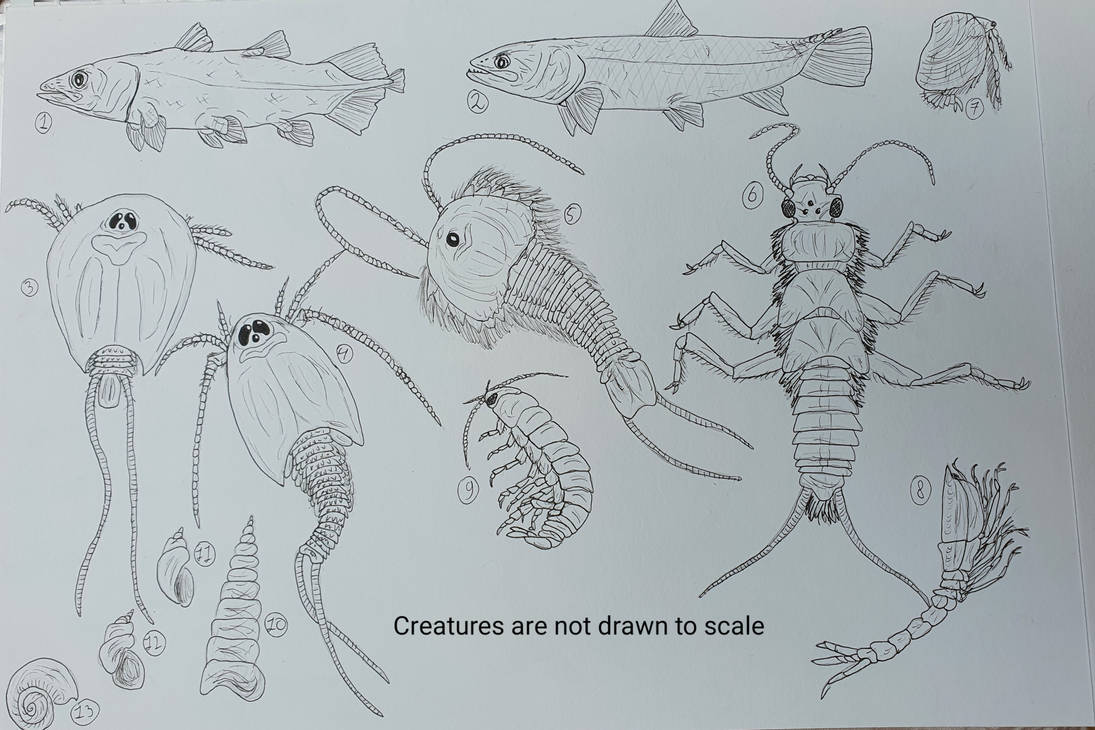"It has become very clear to us that AnVela Koeliv-C-VI, commonly known as Eryobis, was in fact seeded with life from Earth a very, very long time ago. Whatever beings brought life here, left little trace of their activities, which has made determining the exact point life started here hard. While we have found fossils from the earliest ages that appear to be fungi or algae, we had no fossils of animals from that time.
That was, atleast, until we came across this Lagerstätte in North-Eastern Guralta. Dated back at 323.6 million years ago, the fossils found here are the oldest evidence of animals on Eryobis.At the time, this Lagerstätte would've been a brackish estuary and housed a variety of different creatures. The plant life found here is not too different from older fossils, but rather, it's the animals that make this site so important. Some of them have actually been classified in a genus found on Earth back in the Triassic or Jurassic, but most of them have no discovered Earthly counterparts, yet."
Here is a quick description of the fauna in the Lagerstätte:
1) Determined to be a member of the genus Holophagus, this coelacanth has been named Holophagus repositus. This species was on average 37 centimeters long, with some huge individuals reaching almost 50 centimeters.
2) While no Earth based genus seems to match this fish, it has been determined that belongs within the Halecomorphi and possibly even within the Amiiformes. For simplity's sake, it was called Eryobamia antiquus. Most individuals were between 15 and 26 centimeters long.
3) While it has no Terran equal, this notostracan has been classified as Lepidurus Eryobensis . This species was very abundant in the fossil site and measured 3 centimeters long, excluding the caudal furcae.
4) The discovery of a second genus of tadpole shrimp proved the theory that all modern Eryobean notostracans descended from two different ancestors. Named Triops macrops, this species was just as abundant as the Lepidurus, but was a little smaller, measuring 2,8 centimeters long, excluding the caudal furcae.
5) The long standing enigma of the one eyed crustaceans has been solved with the discovery of this species. Determined to be a Kazacharthran of a yet unknown Terran genus, it has been dubbed Eocyclops gigas. From its carapace to its the telson, it measured 12 centimeters long.
6) Probably the most common fossil species in the site, this weird insect caught the researchers off guard. For quite some time, they puzzled over what Jurassic insect was completely aquatic, but they couldn't find anything. Then one day a new paleontologist came over, took a look at it, and then pointed out that it was very similar to a stonefly nymph. This raised the question if it was infact a nymph or a neotenous stonefly. Since the atmosphere back then was even more unbreathable for Terran life then it is now, the chance of it already being neotenous is quite big, although the insane numbers they occurred in might have been the result of an extremely low survival rate with almost all of the adults dying once they leave the water. It was named Guraltoperla puerilis, for it has no Earthly counterpart. Most of them were around 2 centimeters long.
7) Easily recognizable, these clam shrimp were very abundant in the site and based on on their morphology, there may have been up to 15 different species in this site alone, however being hard to identify, they are all classified as Conchostraca indet. They ranged in size from 0.3 to 4 centimeters across their valves.
8) Instantly recognized as a Cumacean, however due to its very generic anatomy, it has been hard to classify it. For now it's known as Cumacea indet. The single individual discovered was 2 centimeters long in total.
9) Identified as an Isopod, but it probably behaved more like an amphipod. It has not been classified yet and is referred to as Isopoda indet. It was 1 centimeter long in total
10-13) Various gastropod shells have been found here, no of which have been properly identified.
"Strangely enough, no brachiopods or bivalves have been found here, leading to the theory that all the original shellfish must have been exclusively marine."
"Even though the species in this Lagerstätte paint a good picture of what the earliest ages on Eryobis would've looked like, according to the genetics and some other modern species, the ones found here appear to be less than half of the introduced species. So all we can do is hope we ever find a similar fossil site, but in an exclusively marine or freshwater setting..."




No comments:
Post a Comment